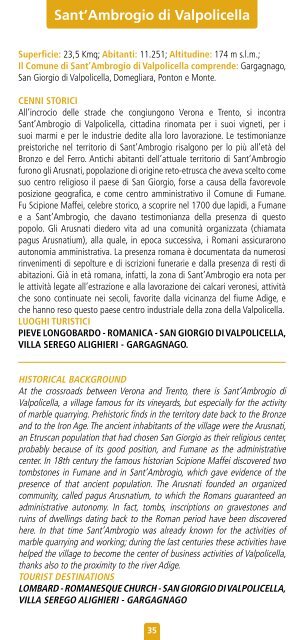Valpolicella Web
Valpolicella Web
Valpolicella Web
Create successful ePaper yourself
Turn your PDF publications into a flip-book with our unique Google optimized e-Paper software.
Sant’Ambrogio di <strong>Valpolicella</strong><br />
Superficie: 23,5 Kmq; Abitanti: 11.251; Altitudine: 174 m s.l.m.;<br />
Il Comune di Sant’Ambrogio di <strong>Valpolicella</strong> comprende: Gargagnago,<br />
San Giorgio di <strong>Valpolicella</strong>, Domegliara, Ponton e Monte.<br />
CENNI STORICI<br />
All’incrocio delle strade che congiungono Verona e Trento, si incontra<br />
Sant’Ambrogio di <strong>Valpolicella</strong>, cittadina rinomata per i suoi vigneti, per i<br />
suoi marmi e per le industrie dedite alla loro lavorazione. Le testimonianze<br />
preistoriche nel territorio di Sant’Ambrogio risalgono per lo più all’età del<br />
Bronzo e del Ferro. Antichi abitanti dell’attuale territorio di Sant’Ambrogio<br />
furono gli Arusnati, popolazione di origine reto-etrusca che aveva scelto come<br />
suo centro religioso il paese di San Giorgio, forse a causa della favorevole<br />
posizione geografica, e come centro amministrativo il Comune di Fumane.<br />
Fu Scipione Maffei, celebre storico, a scoprire nel 1700 due lapidi, a Fumane<br />
e a Sant’Ambrogio, che davano testimonianza della presenza di questo<br />
popolo. Gli Arusnati diedero vita ad una comunità organizzata (chiamata<br />
pagus Arusnatium), alla quale, in epoca successiva, i Romani assicurarono<br />
autonomia amministrativa. La presenza romana è documentata da numerosi<br />
rinvenimenti di sepolture e di iscrizioni funerarie e dalla presenza di resti di<br />
abitazioni. Già in età romana, infatti, la zona di Sant’Ambrogio era nota per<br />
le attività legate all’estrazione e alla lavorazione dei calcari veronesi, attività<br />
che sono continuate nei secoli, favorite dalla vicinanza del fiume Adige, e<br />
che hanno reso questo paese centro industriale della zona della <strong>Valpolicella</strong>.<br />
LUOGHI TURISTICI<br />
PIEVE LONGOBARDO - ROMANICA - SAN GIORGIO DI VALPOLICELLA,<br />
VILLA SEREGO ALIGHIERI - GARGAGNAGO.<br />
HISTORICAL BACKGROUND<br />
At the crossroads between Verona and Trento, there is Sant’Ambrogio di<br />
<strong>Valpolicella</strong>, a village famous for its vineyards, but especially for the activity<br />
of marble quarrying. Prehistoric finds in the territory date back to the Bronze<br />
and to the Iron Age. The ancient inhabitants of the village were the Arusnati,<br />
an Etruscan population that had chosen San Giorgio as their religious center,<br />
probably because of its good position, and Fumane as the administrative<br />
center. In 18th century the famous historian Scipione Maffei discovered two<br />
tombstones in Fumane and in Sant’Ambrogio, which gave evidence of the<br />
presence of that ancient population. The Arusnati founded an organized<br />
community, called pagus Arusnatium, to which the Romans guaranteed an<br />
administrative autonomy. In fact, tombs, inscriptions on gravestones and<br />
ruins of dwellings dating back to the Roman period have been discovered<br />
here. In that time Sant’Ambrogio was already known for the activities of<br />
marble quarrying and working; during the last centuries these activities have<br />
helped the village to become the center of business activities of <strong>Valpolicella</strong>,<br />
thanks also to the proximity to the river Adige.<br />
TOURIST DESTINATIONS<br />
LOMBARD - ROMANESQUE CHURCH - SAN GIORGIO DI VALPOLICELLA,<br />
VILLA SEREGO ALIGHIERI - GARGAGNAGO<br />
35





